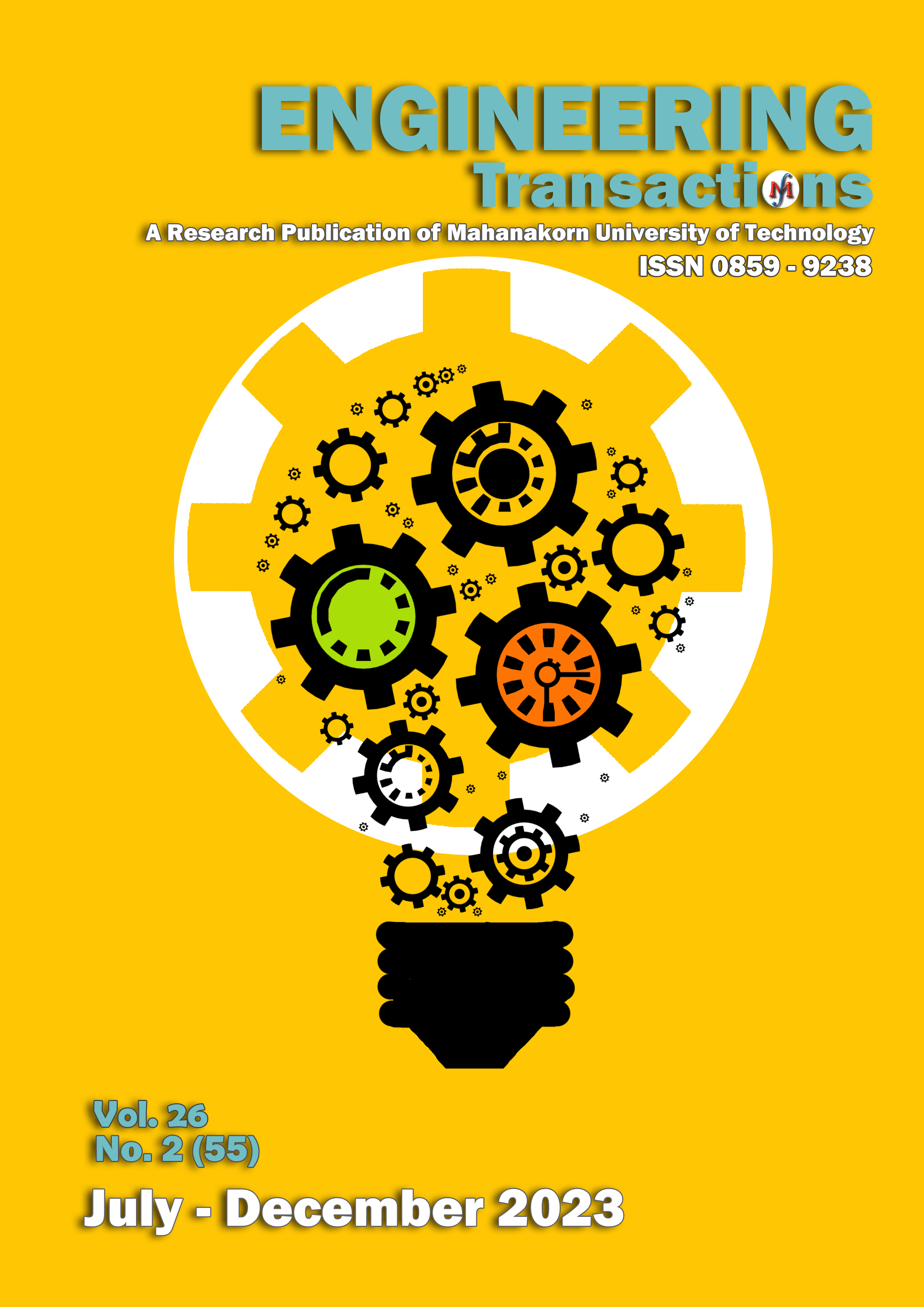Waste Reduction in Packing Process of Coloured Pencils
Main Article Content
Abstract
This research aims to reduce waste produced during the packing process of coloured pencils. Cause and effect diagram was applied as the tool to find the causes of the waste in the a packing process. There were three main causes of waste: delay, motion and defect. Delay and motion, method and workspace were analyzed. It was found that the arrangement of the crates was not proper and the positioning of the crate and boxes was unclear. These led to employees intervened because of using their eyesight to find coloured pencils in boxes. Defect, positioning equipment was investigated. It was found that the equipment was inefficient. These 3 issues were solved by adjusting the layout of the packing process with the application of FSN analysis of warehouse management and improving the positioning equipment by applying engineering design theory. The results showed that the waste of the delay of 12 coloured pencils was reduced from 0.93 second per box to 0.54 second per box, representing 41.94 percent of decrement, or reduced from 579 seconds per cycle to 338 seconds per cycle, representing 41.62 percent decrease. For 24 coloured pencils, the waste of the delay was reduced from 3.42 seconds per box to 1.87 seconds per box, representing 45.03 percent of decrement, or reduced from 1148 seconds per cycle to 629 seconds per cycle, representing 45.21 percent of decrement. Futhermore the waste of the motion of 12 coloured pencils was reduced from 254.33 meters to 109.61 meters, representing 56.90 percent of decrement. For, 24 coloured pencils, the waste of the motion was reduced from 359.41 meters to 218.33 meters, representing 39.25 percent of decrement. Finally, the waste of the defect of 12 coloured pencils was reduced from 0.24 percent to 0.12 percent, representing 50.00 percent of decrement. For, 24 coloured pencils, the waste of the defect was reduced from 0.39 percent to 0.13 percent, representing 66.67 percent of decrement.
Article Details

This work is licensed under a Creative Commons Attribution-NonCommercial-NoDerivatives 4.0 International License.
Copyright @2021 Engineering Transactions
Faculty of Engineering and Technology
Mahanakorn University of Technology
References
พิรดา โป๊ะลำพงษ์, “แผนธุรกิจร้านเครื่องเขียนและอุปกรณ์สำนักงาน”, [online] https://tdc.thailis.or.th/tdc/browse.php, สืบค้นเมื่อ 15/07/2565.
ไรท์ติ้งอินไทย, “ประเมินผลกระทบ COVID-19 กับอุตสาหกรรมเครื่องเขียน: 1 ปีกับโรคเปลี่ยนโลก”, [online] https://writing.in.th/2021/04/11/covid-19-and-its-impact-writing-instrument-thailand/, สืบค้นเมื่อ 15/07/2565.
ประชาชาติธุรกิจ, “63 ปี เครื่องเขียน “สมใจ” จากร้านในตำนาน สู่ยุคดิจิทัล”, [online] https://www.prachachat.net/marketing/news-209849, สืบค้นเมื่อ 15/07/2565.
ประยูร เชี่ยววัฒนา, “ไคเซ็นตามวิถีโตโยต้า”, สมาคมส่งเสริมเทคโนโลยี (ไทย-ญี่ปุ่น), 2554.
ยุทธณรงค์ จงจันทร์, ยอดนภา เกตุเมือง, และ นรา บุริพันธ์, “การจัดสมดุลสายการผลิตเพื่อลดความสูญเปล่าในกระบวนการผลิตติดตั้งดั้มพ์,” In Proc. IE Network Conference 2012’ เพชรบุรี, กรุงเทพฯ, หน้า 281-288, 2555.
คลอเคลีย วจนะวิชากร, ปานจิต ศรีสวัสดิ์, และวรัญญู ทิพย์โพธิ์, “การปรับปรุงประสิทธิภาพกระบวนการผลิตเพื่อลดความสูญเปล่าและเพิ่มคุณภาพผลิตภัณฑ์เครื่องปั้นดินเผา”, บทความวิจัย วารสารวิชาการ วิศวกรรมศาสตร์ ม.อบ., ปีที่ 9 ฉบับที่ 2, หน้า 38-46, 2559.
กิติศักดิ์ พลอยพานิชเจริญ, “หลักการควบคุมคุณภาพ”, สำนักพิมพ์สมาคมส่งเสริมเทคโนโลยี (ไทย-ญี่ปุ่น), 2551.
A.T. James, and D.S. Jerry, “The Warehouse Management Handbook,” 1st Ed., Mcgraw-Hill (Tx), 1998.
คำนาย อภิปรัชญาสกุล, “การจัดการคลังสินค้า,” พิมพ์ครั้งที่ 1., บริษัท โฟกัสมีเดีย แอนด์พับลิชชิ่ง จำกัด, 2560,
N.K. Shimbun, “Visual Control Systems” 1st Edition., Productivity Press, 1995.
C. A. Ortiz, and M. Park, “Visual Controls: Applying Visual Management to the Factory ” 1st Ed., Productivity Press, 2010.
สุรชัย ธรรมทวีธิกุล, และ วิเชียร เบญจวัฒนาผล, “ระบบการผลิต JIT: จากหลักการสู่ภาคปฏิบัติจริง / โดย ฮิโรยูคิ ฮิราโน่”, ซีเอ็ดยูเคชั่น, 2537.
บัญชา ธนบุญสมบัติ, “การออกแบบทางวิศวกรรม:การเลือกใช้วัสดุและกรรมวิธีการผลิต”, สมาคมส่งเสริมเทคโนโลยี (ไทย-ญี่ปุ่น), 2543.
M. F. Ashby, “Materials Selection in Mechanical Design” 5th Ed., Butterworth-Heinemann, 2017.
อัญชลี คำหนู, และ วสวัชร นาคเขียว, “การปรับปรุงประสิทธิภาพการบริหารคลังสินค้า สำหรับโรงงานอาหารเสริมสาหร่ายสไปรูลิน่า,” งานสัมมนาทางวิชาการวิศวกรรมอุตสาหการและการจัดการอุตสาหกรรมปี ครั้งที่ 2, 2561.
ชญาดา ปราชเปรื่อง, และ รุ่งฉัตร ชมภูอินไหว, “การลดเวลาในการผลิตกระเทียมกลีบไทยบรรจุถุงด้วยเทคนิคการผลิตแบบลีน,” งานสัมมนาทางวิชาการวิศวกรรมอุตสาหการและการจัดการอุตสาหกรรมปี ครั้งที่ 1, 2560.
B. Suhardi, and P. W. Laksono, “Minimizing waste using lean manufacturing and ECRS principle in Indonesian furniture industry”, Cogent Engineering., vol 6, pp. 1-13, 2019.
B. Ali, S. Jaweed, and M. Fahad, “Implementation of Waste Assessment Matrix and Line Balancing For Productivity Improvement in a High Variety/High Volume Manufacturing Plant”, In: Proc. of ESMD, Karachi, Pakistan, pp. 68–75, 2015.
ศุภชัย ตระกูลทรัพย์ทวี, “การเขียนแบบวิศวกรรมด้วย SolidWorks”, สมาคมส่งเสริมเทคโนโลยี (ไทย-ญี่ปุ่น), 2552.
นันทณัฐ เยื่อบางไทร, ไชยาพงษ์ เทพประสิทธิ์ และ วราวุธ วุฒิวณิชย์, “การประเมินสภาพฝายด้วยเทคนิควิธีดัชนีสภาพและกระบวนการวิเคราะห์ลำดับขั้น”, วารสารวิชาการพระจอมเกล้าพระนครเหนือ, ปีที่ 30, ฉบับที่ 3, หน้า 389-405, 2563.


